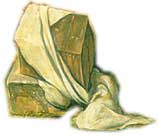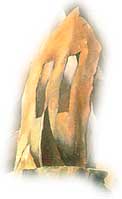- 1 -
Painting
the Subject of the Holocaust
The defining moment
that brought me to the present form of my art happened some thirty-five
years ago. It has been no intellectual journey, not the kind of search
that many self-aware artists, conscious of their place in the ever-evolving
story of art, go through before reaching their characteristic style. Rather
I was responding to something that was pushing out from the inside, something
visceral, something that takes a long time for the mind to comprehend.
 The
world of images that populated my paintings thirty-five years ago was
very close to what it still is today. I know how my present art is perceived,
and I feel comfortable about it. But at that time I had no intention of
producing work that would automatically identify me with the experience
of the Holocaust. Being a survivor, I was familiar with the world's reluctance
to listen to our harrowing stories. This reluctance to expose ancient
wounds might also come from a fear of being thought to solicit commiseration.
We live in a society that hungers for sentiment. Thus my fragile inner
images, ready to be transferred onto canvas, had to be protected from
exploitation. And so my antiquated style of painting also served to shield
their meaning from too-easy access. I guess that I was looking for a place
"far from the madding crowd", for an art that would exude an
aura of timelessness. The
world of images that populated my paintings thirty-five years ago was
very close to what it still is today. I know how my present art is perceived,
and I feel comfortable about it. But at that time I had no intention of
producing work that would automatically identify me with the experience
of the Holocaust. Being a survivor, I was familiar with the world's reluctance
to listen to our harrowing stories. This reluctance to expose ancient
wounds might also come from a fear of being thought to solicit commiseration.
We live in a society that hungers for sentiment. Thus my fragile inner
images, ready to be transferred onto canvas, had to be protected from
exploitation. And so my antiquated style of painting also served to shield
their meaning from too-easy access. I guess that I was looking for a place
"far from the madding crowd", for an art that would exude an
aura of timelessness.
These representational
paintings of mine depicted devastated landscapes of ancient cities, urban
constructions that seemed to be made of a child's building blocks. I painted
figures that were half-alive, and half-contrived of bizarre prostheses.
I imagined helpless and abused angels. Chess pieces were involved in games
without rules. Huge fruit, mostly pears in various stages of re-invention
— pears giving birth to other pears, pears
made of stone, pears in the form of hovering planets —
metaphors of a world without explanations. My paintings carried no answers,
only questions.
Yet although I resisted
making the connection explicit, these were questions that for me, personally,
returned always to the experience of the Holocaust. Chimneys, sprouting
heavy smoke and made of clusters of stones that reminded me of cemeteries,
had already been hiding in my earlier paintings. Yet I still named such
paintings Ancient Industries, hoping that no one would guess what they
meant to me.
 In
1974 a contract with a New York gallery disconnected me from the "old
world" that had given me a sense of identity and brought me for a
few years to Manhattan. It was there that the Jewish symbols began to
enter directly into my work. The star of David that I had to wear as a
young boy in the ghetto stitched to my clothes; the tablets of the law,
which adorned most synagogues; the extinguished candles of Sabbath. Two
decades later I added to them the figure of the Warsaw ghetto boy with
his lifted arms, that most iconic of all Holocaust images, a Jewish crucifixion. In
1974 a contract with a New York gallery disconnected me from the "old
world" that had given me a sense of identity and brought me for a
few years to Manhattan. It was there that the Jewish symbols began to
enter directly into my work. The star of David that I had to wear as a
young boy in the ghetto stitched to my clothes; the tablets of the law,
which adorned most synagogues; the extinguished candles of Sabbath. Two
decades later I added to them the figure of the Warsaw ghetto boy with
his lifted arms, that most iconic of all Holocaust images, a Jewish crucifixion.
From the beginning
I have believed that specifically Holocaust-related interpretation would
narrow the meaning of my work. After all, I was trying to express a universal
malaise about our human condition. The experience of the Holocaust shed
such a cruel light on the vast catalogue of human behavior that its lesson
had to be hard to absorb; people needed time to study it and to grasp
all its implications. Moreover, thirty-five years ago the Holocaust was
considered mainly a calamity only of the Jewish people.
There were several
other reasons why I shied away from a direct connection with the Holocaust.
First, I did not like the term. In its biblical origin it meant a burnt
offering that was proposed to God Almighty by a high priest. I felt it
thus carried a notion of self-sacrifice that did not respect the desire
for life to which millions of victims had clung desperately though in
vain. It belittled the magnitude of their tragedy.
 Second,
most of the art that I then encountered on this theme, art produced in
the sixties and seventies, was to my eyes less than acceptable. Some powerful
works must already have existed, but I was unfamiliar with them. It often
felt as if the overpowering importance of the subject was expected to
compensate for the lack of artistic imagination and force. A few decades
ago many serious and creative artists refrained from touching the theme
of the Holocaust. Second,
most of the art that I then encountered on this theme, art produced in
the sixties and seventies, was to my eyes less than acceptable. Some powerful
works must already have existed, but I was unfamiliar with them. It often
felt as if the overpowering importance of the subject was expected to
compensate for the lack of artistic imagination and force. A few decades
ago many serious and creative artists refrained from touching the theme
of the Holocaust.
Fortunately, this
situation has evolved. At present, the challenge of anchoring art in meaningful
themes does not scare away talented artists. On the contrary, subject
now matters. As for the problematic denomination of the Jewish genocide:
the word Holocaust has become so familiar that it has transcended its
etymology.
But there was another
reason I hesitated to connect my work exclusively to that portentous event.
I suspected that my art was being used improperly. Perhaps, for the purpose
of whitewashing a disturbing conscience. Perhaps, for placing it into
a space that was temporarily "fashionable." I feared that, unwillingly,
I was being launched on an ambiguous trajectory that exploited my grievous
personal losses for what could be seen as an advancement of career.
 |
From:
About Myself by Samuel Bak. By permission of The Pucker Gallery. |

Exhibitions
in Germany ¦ BAK
Introduction
|



